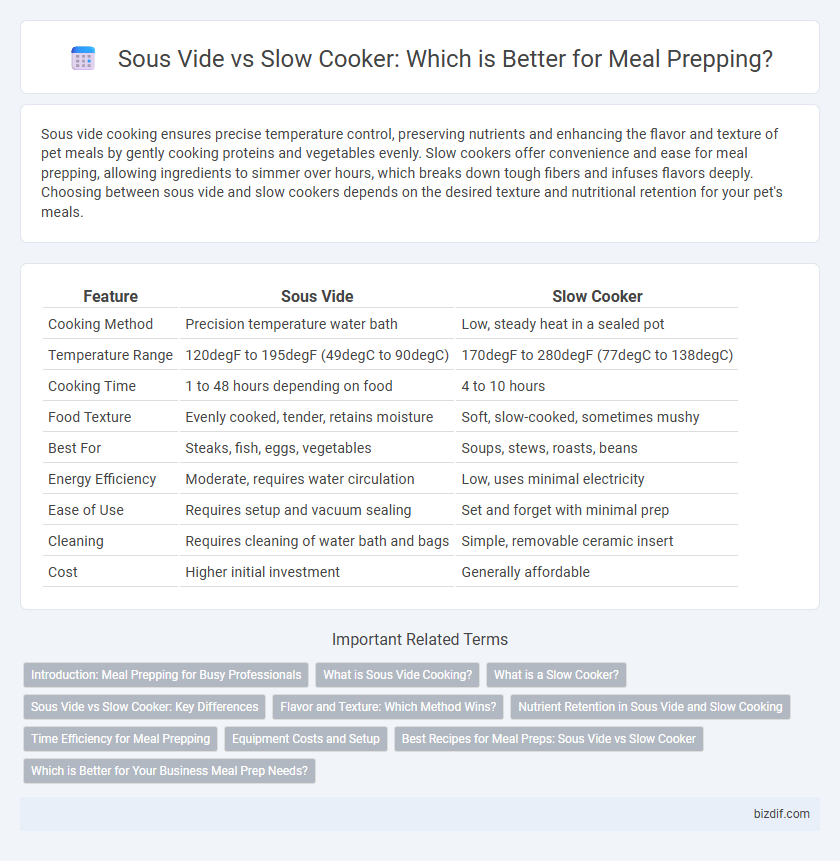Sous vide cooking ensures precise temperature control, preserving nutrients and enhancing the flavor and texture of pet meals by gently cooking proteins and vegetables evenly. Slow cookers offer convenience and ease for meal prepping, allowing ingredients to simmer over hours, which breaks down tough fibers and infuses flavors deeply. Choosing between sous vide and slow cookers depends on the desired texture and nutritional retention for your pet's meals.
Table of Comparison
| Feature | Sous Vide | Slow Cooker |
|---|---|---|
| Cooking Method | Precision temperature water bath | Low, steady heat in a sealed pot |
| Temperature Range | 120degF to 195degF (49degC to 90degC) | 170degF to 280degF (77degC to 138degC) |
| Cooking Time | 1 to 48 hours depending on food | 4 to 10 hours |
| Food Texture | Evenly cooked, tender, retains moisture | Soft, slow-cooked, sometimes mushy |
| Best For | Steaks, fish, eggs, vegetables | Soups, stews, roasts, beans |
| Energy Efficiency | Moderate, requires water circulation | Low, uses minimal electricity |
| Ease of Use | Requires setup and vacuum sealing | Set and forget with minimal prep |
| Cleaning | Requires cleaning of water bath and bags | Simple, removable ceramic insert |
| Cost | Higher initial investment | Generally affordable |
Introduction: Meal Prepping for Busy Professionals
Sous vide and slow cookers are popular tools for meal prepping among busy professionals seeking convenience and consistent results. Sous vide ensures precise temperature control for perfectly cooked meals, while slow cookers offer effortless, hands-off cooking with minimal supervision. Both methods save time during the week by allowing batch cooking and easy meal storage.
What is Sous Vide Cooking?
Sous vide cooking is a precise method where food is vacuum-sealed in a bag and cooked in a water bath at a consistently low temperature, ensuring even doneness and retention of moisture and flavor. This technique allows for exact control over cooking time and temperature, which can enhance the texture and tenderness of proteins, vegetables, and other ingredients. Compared to slow cooking, sous vide prevents overcooking and nutrient loss, making it ideal for meal prepping dishes that require consistent quality and freshness.
What is a Slow Cooker?
A slow cooker is an electric countertop appliance designed to cook food at a consistent low temperature over several hours, ideal for meal prepping. It uses a sealed pot to retain moisture, allowing tough cuts of meat and ingredients to become tender without constant supervision. Slow cookers offer convenience by enabling users to prepare meals ahead of time and set them to cook while away.
Sous Vide vs Slow Cooker: Key Differences
Sous vide cooking involves vacuum-sealing food and cooking it in a precisely controlled water bath at a consistent temperature, ensuring even doneness and superior texture. Slow cookers use low, steady heat over several hours, ideal for breaking down tougher cuts of meat and developing deep flavors. Sous vide provides precise temperature control for consistent results, while slow cookers offer convenience for unattended, long-duration cooking.
Flavor and Texture: Which Method Wins?
Sous vide cooking delivers precise temperature control that enhances flavor infusion and creates consistently tender textures by evenly cooking food without overcooking. Slow cookers excel in developing deep, rich flavors through long, gentle simmering, but may result in softer, sometimes mushy textures depending on the ingredient. For optimal flavor and texture balance, sous vide is preferred for delicate proteins, while slow cookers are ideal for hearty, tougher cuts requiring extended cooking times.
Nutrient Retention in Sous Vide and Slow Cooking
Sous vide cooking preserves nutrients by sealing food in airtight bags and cooking at precise, low temperatures, minimizing nutrient loss from oxidation and water exposure. Slow cookers use prolonged heat and moisture, which can cause some vitamins, especially water-soluble ones like vitamin C and B-complex, to degrade over time. Studies show sous vide retains more antioxidants and nutrients overall compared to slow cooking, making it a superior method for nutrient retention in meal prepping.
Time Efficiency for Meal Prepping
Sous vide offers precise temperature control resulting in consistent, evenly cooked meals, but generally requires longer cooking times ranging from 1 to 8 hours, making it less time-efficient for quick meal prepping. Slow cookers provide the convenience of set-and-forget cooking with typical durations of 4 to 10 hours, allowing users to prepare meals overnight or during work hours, enhancing overall time management for busy schedules. When prioritizing time efficiency, slow cookers offer more flexibility and less active monitoring compared to the longer, more controlled sous vide method.
Equipment Costs and Setup
Sous vide machines typically range from $100 to $300, offering precise temperature control with compact setups that fit easily in small kitchens. Slow cookers are more budget-friendly, usually priced between $30 and $100, and require minimal setup with simple plug-and-play operation. Both devices offer affordable options, but sous vide equipment demands slightly higher initial investment due to its advanced technology and accessories.
Best Recipes for Meal Preps: Sous Vide vs Slow Cooker
Sous vide excels in meal prepping recipes that require precise temperature control, such as perfectly cooked chicken breasts, tender steaks, and vegetables that retain vibrant color and nutrients. Slow cookers are ideal for hearty, set-it-and-forget-it meals like stews, chili, and pulled pork, which develop deep flavors over extended cooking times. Choosing between sous vide and slow cooker depends on meal prep goals: sous vide delivers consistent texture for protein-centric dishes, while slow cookers provide convenience and rich, slow-cooked flavors for one-pot recipes.
Which is Better for Your Business Meal Prep Needs?
Sous vide offers precise temperature control and consistent results, ideal for meal prep businesses requiring uniform quality and extended shelf life. Slow cookers excel in batch cooking large quantities with minimal supervision, perfect for cost-effective, hearty meals. Choosing between sous vide and slow cookers depends on your business model's emphasis on texture precision versus volume efficiency.
Sous vide vs slow cooker Infographic

 bizdif.com
bizdif.com